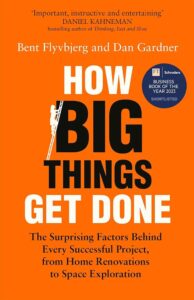“How Big Things Get Done” offers a fascinating insight into the world of project management, with Flyvbjerg and Gardner highlighting unexpected and crucial factors that determine the success of projects. This book is relevant not only to project managers, but also to a wider audience.
Why is this book worth reading?
- Unravelling complexity: Flyvbjerg and Gardner unravel complex projects and illustrate how they function without a one-size-fits-all approach, providing a better understanding of successful project implementation.
- Universal applicability: Regardless of whether you are working on a home renovation, leading a start-up, or involved in groundbreaking space missions, the principles discussed are relevant to any project.
- Inspiring stories: With engaging anecdotes and case studies, Flyvbjerg and Gardner underline their findings and make the book both instructive and entertaining.
- New perspectives: “How Big Things Get Done” challenges common patterns of thinking in project management and suggests innovative approaches to approach ambitious projects more confidently.
This book will increase your understanding of why some projects succeed and others fail, and it will inspire you to be more confident in tackling projects, regardless of their size. If you are interested in project management, “How Big Things Get Done” provides valuable insights and inspiration.

Ready for next level product development?
Let's create a digital product that end users and business stakeholders will love and that is also future-proof, scalable, secure and easy to maintain.

 1 min
1 min 

